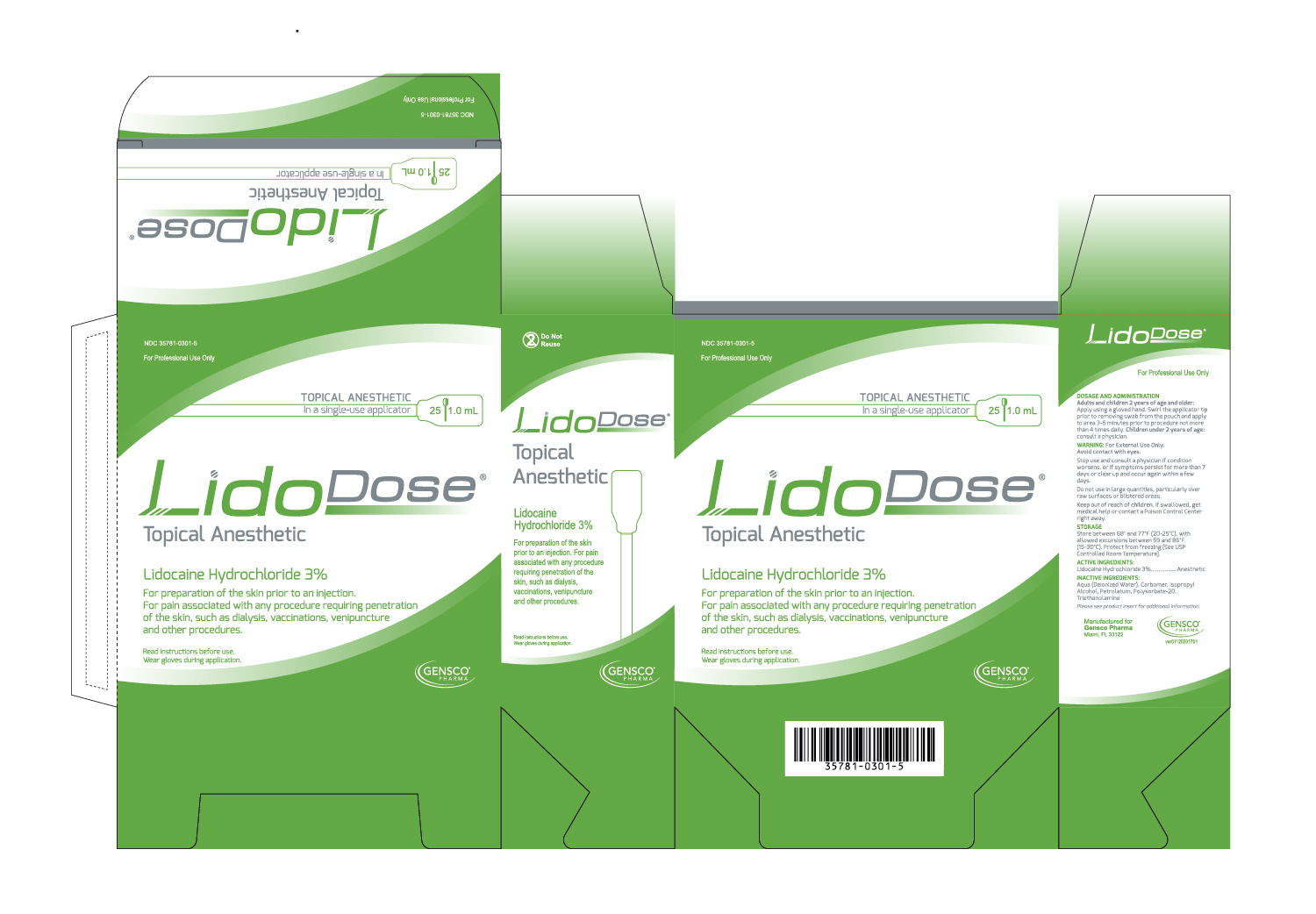Label: LIDODOSE- lidocaine hydrochloride gel
-
Contains inactivated NDC Code(s)
NDC Code(s): 35781-0301-0, 35781-0301-1, 35781-0301-5 - Packager: Gensco Laboratories, LLC
- Category: HUMAN OTC DRUG LABEL
- DEA Schedule: None
- Marketing Status: OTC monograph not final
DISCLAIMER: Most OTC drugs are not reviewed and approved by FDA, however they may be marketed if they comply with applicable regulations and policies. FDA has not evaluated whether this product complies.
Drug Label Information
Updated October 4, 2022
If you are a consumer or patient please visit this version.
- Download DRUG LABEL INFO: PDF XML
- Official Label (Printer Friendly)
- Dosage and Administration
- Usage
-
Warning: for external use only.
Methemoglobinemia
Cases of methemoglobinemia have been reported in association with local anesthetic use. Although all patients are at risk for methemoglobinemia, patients with glucose-6-phosphate dehydrogenase deficiency, congenital or idiopathic methemoglobinemia, cardiac or pulmonary compromise, infants under 6 months of age, and concurrent exposure to oxidizing agents or their metabolites are more susceptible to developing clinical manifestations of the condition. If local anesthetics must be used in these patients, close monitoring for symptoms and signs of methemoglobinemia is recommended.
Signs and symptoms of methemoglobinemia may occur immediately or may be delayed some hours after exposure and are characterized by a cyanotic skin discoloration and abnormal coloration of the blood. Methemoglobin levels may continue to rise; therefore, immediate treatment is required to avert more serious central nervous system and cardiovascular adverse effects, including seizures, coma, arrhythmias, and death. Discontinue LidoDose and any other oxidizing agents. Depending on the severity of the symptoms, patients may respond to supportive care, i.e., oxygen therapy, hydration. More severe symptoms may require treatment with methylene blue, exchange transfusion, or hyperbaric oxygen.Avoid contact with eyes.
Stop use and consult a physician if condition worsens, or if symptoms persist for more than 7 days or clear up and occur again within a few days. Do not use in large quantities, particularly over raw surfaces or blistered areas.
-
DRUG INTERACTIONS
Patients that are administered local anesthetics may be at increased risk of developing methemoglobinemia when concurrently exposed to the following oxidizing agents:
Class Examples Nitrates/Nitrites nitroglycerin, nitroprusside, nitric oxide, nitrous oxide Local anesthetics benzocaine, lidocaine, bupivacaine, inepivacaine, tetracaine, prilocaine, procaine, articaine, ropivacaine Antineoplastic agents cyclophosphamide, flutamide, rasburicase, ifosfamide, hydroxyurea Antibiotics dapsone, sulfonamides, nitrofurantoin, para¬aminosalicylic acid Antimalarials chloroquine, primaquine Anticonvulsants phenytoin, sodium valproate, phenobarbital Other drugs acetaminophen, metoclopramide, sulfa drugs (i.e., sulfasalazine), quinine - Keep out of reach of children
- Storage
-
PATIENT COUNSELING INFORMATION
Inform patients that use of local anesthetics may cause methemoglobinemia, a serious condition that must be treated promptly. Advise patients or caregivers to stop use and seek immediate medical attention if they or someone in their care experience the following signs or symptoms: pale, gray, or blue colored skin (cyanosis); headache; rapid heart rate; shortness of breath; lightheadedness; or fatigue.
- Active Ingredients:
- Inactive Ingredients:
- SPL UNCLASSIFIED SECTION
- LIDO DOSE
-
INGREDIENTS AND APPEARANCE
LIDODOSE
lidocaine hydrochloride gelProduct Information Product Type HUMAN OTC DRUG Item Code (Source) NDC:35781-0301 Route of Administration TOPICAL Active Ingredient/Active Moiety Ingredient Name Basis of Strength Strength LIDOCAINE HYDROCHLORIDE (UNII: V13007Z41A) (LIDOCAINE - UNII:98PI200987) LIDOCAINE HYDROCHLORIDE ANHYDROUS 3 mg in 100 mL Inactive Ingredients Ingredient Name Strength WATER (UNII: 059QF0KO0R) CARBOMER HOMOPOLYMER TYPE C (ALLYL PENTAERYTHRITOL CROSSLINKED) (UNII: 4Q93RCW27E) ISOPROPYL ALCOHOL (UNII: ND2M416302) PETROLATUM (UNII: 4T6H12BN9U) POLYSORBATE 20 (UNII: 7T1F30V5YH) TRIETHANANOLAMINE PHENYLBENZIMIDAZOLE SULFONATE (UNII: TQA10H23WC) Packaging # Item Code Package Description Marketing Start Date Marketing End Date 1 NDC:35781-0301-5 25 in 1 BOX 01/01/2018 1 NDC:35781-0301-0 1 mL in 1 POUCH; Type 0: Not a Combination Product 2 NDC:35781-0301-1 100 in 1 BOX 01/01/2018 2 NDC:35781-0301-0 1 mL in 1 POUCH; Type 0: Not a Combination Product Marketing Information Marketing Category Application Number or Monograph Citation Marketing Start Date Marketing End Date OTC monograph not final part348 01/01/2018 Labeler - Gensco Laboratories, LLC (831042325)






